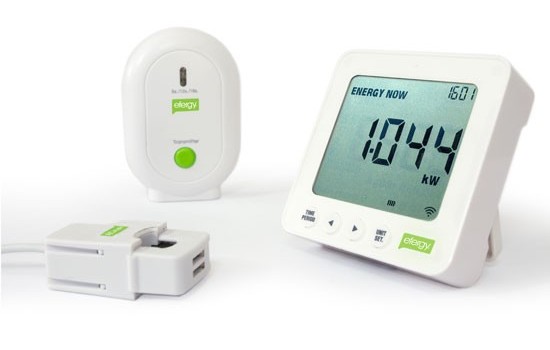
[Update: From now on, energy monitors will largely be replaced by modern ‘smart meters’. Find information on smart meters here.]
What is an energy monitor?
Energy monitors do very much what they say on the tin – they are used to measure the amount of energy used in the home. These handheld gadgets don’t lower energy usage by themselves; their purpose is more to help the bill payer be aware of how much energy they are using. By 2020, most homes in the UK will have smart meters installed, which show you your energy usage, as well as sending it automatically to your energy provider. Therefore, rather than investing in a new basic monitor now, it’s probably worth asking your energy company to give you a smart model for free!
How do energy monitors work?
An energy monitor comes with a sensor, a transmitter and a handheld or portable display. The sensor is attached around the main electricity line going into your meter and the transmitter will then be able to send instantaneous energy usage information, back to the monitor. Usually this will be in the form of Kilowatt Hours, carbon emissions or cost, with most monitors able to let you choose how you want the information displayed.
The limitations of energy monitors
It is important to stress that because the data is collected via the sensor, and not direct from the electric meter, the usage data is not 100% accurate. However it should still provide you with a decent way of seeing how different appliances being switched on alter the electricity usage in the home. It is also worth mentioning that as a rule of thumb you get what you pay for; therefore if you are willing to pay £50 for your monitor, it is most likely going to give you more accurate readings than a £15 version.
In addition, energy monitors do not communicate with your energy provider. It is a common misconception, but the monitors are there for your use only, and there is no link with any other party. When smart meters get rolled out at the end of the decade this will change, and suddenly we may enter an age when electricity is priced by the minute!
What energy monitors allow you to do
To a certain extent this depends on how much you spend, since aside from increased accuracy, spending more on an energy monitor normally means that it will come packed with more features. For example, the Efergy E2 Classic Energy monitor allows you to calibrate it with multiple tariff prices which therefore gives you a much more accurate picture of how much it is costing in terms of electricity to run the home.
Regardless of how much you spend though, energy monitors on their own do not save energy. Instead they require you to engage with the device – if you buy one with this in mind you can make substantial savings on your electricity bill.
Suddenly you have the ability to actually see the financial impact of turning on an additional appliance in the home. You can see that running an incandescent bulb is more expensive than an LED and that actually keeping your oven on for 2 hours to cook a roast is expensive. You can see that running a washing machine at night is materially cheaper if you are on an Economy 7 electricity tariff. Take a look at the video below, showing the impact of turning on a tumble dryer in the home on energy usage!
With this kind of information to hand, it is very easy to start making fundamental changes to the way you use energy. You can see the financial impacts of your energy usage decisions in real time, which makes them a very worthwhile gadget. Of course over time they will become less useful, since you will begin to recognise that certain appliances are electricity guzzlers. However they should serve as a constant reminder.
There are also models of energy monitor that allow you to see how much electricity you are generating from your solar PV installation or wind turbines. These are useful for establishing when there is ‘free electricity’ in the home – i.e. you are producing more electricity than is actually being consumed in the home. Since buying electricity from the grid costs 15p / kWh but exporting it (under the Feed-in tariff) only pays 4.64p/kWh, you are better off using as much of the electricity you produce as you can (without increasing your usage – that defeats the object!). These more advanced models of energy monitor notify you when you should use the excess, so you know when to turn on the washing machine/dishwasher, for example.
The Energy Saving Trust have estimated though that people will save about 15% on their electricity bills after installing an energy monitor if they fully interact with it and change their energy usage behaviour.
Plug-in energy monitors
Now entering the market are plug-in energy monitors, costing from £10-25. These allow you to monitor the energy use from a single appliance, and therefore allow a little more precision than a standard energy monitor. You can easily swap from one appliance to another to check the energy consumption and get a better idea of what each appliance costs you.
These monitors might be considered more useful as they can give an appliance by appliance understanding of where you use energy, rather than what some would describe as a glorified electricity meter. Its easily portable nature means you can use it on lots of different appliance.
So are these devices more effective at reducing your consumption? Since they let you get a better understanding of the energy use of each appliance, it is expected that you are more likely to act and change your energy use. They are very new to the market however, so it remains to be seen just how well these work in the home.
Benefits
- Energy monitors provide you with the information that should help you change your energy usage behaviour for the better.
- Some users of energy monitors report savings of 15% on the electricity bills.
Limitations
- They are not 100% accurate since they don’t actually feed into the electricity meter.
- By themselves, they are not going to save you energy – you do need to interact with the monitor.
Cost
- Energy monitors cost anywhere between £20 – £100. Or you can get one for free from your energy provider!













I was wondering what type of energy monitor you recommend? I am keen to invest in one, but there are lots of brands out there and don’t know where to start! Thanks!
Hi Jack, I bought the Efergy engage hub. It allows you to view your energy usage on your mobile. I have apple, but think it works on android too. It is fantastic for the price – so really recommend it.
To be honest you need to decide what functionality you need. Very few meters provide gas readings, and likewise for solar PV output. It also depends on your electricity usage too – are you on Economy 7 because if so you will need a meter that can handle dual rates.
If you just want a really simple meter, the Efergy meters are very nice providing accurate readings.
Surely once you install an energy monitor you very quickly realise what are the energy ‘vampires’ and so don’t use them – then whats the point apart from showing off to your friends!!
That is a fair point Leo, I think if you are very aware of energy usage, then you are going to know much of what they tell you. The fact you talk about energy vampires suggests you are familiar with the types of appliances that do drain more power (tumble dryers, electric showers), so if you can try to find away to minimise usage of these then you should be okay.
It is very interesting to see the monitors spike though when you flick the kettle switch on!